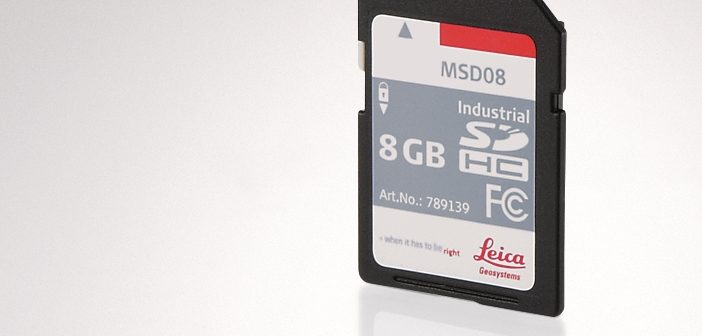Imagine a measurement professional who has finished a working day. Everything worked out fine – the instrument did its job accurately and reliably as every day. On the next day, however, your colleague, who does the office work based on your measurements, calls you. The data from the memory card is erroneous. The work of a whole day is lost.
Every measurement professional who has experienced a situation like this will do everything to avoid it a second time in the future. Data storage devices for surveying tasks must work reliably under the worst possible environmental conditions. Leica Geosystems, therefore, invests a lot into the development of trustworthy and durable storage mediums. Original Leica Geosystems storage devices are different to off-the-shelf products.
Here are the facts:
- Reliable products, exclusively produced by selected providers, tested and approved by Leica Geosystems
At Leica Geosystems AG, only suppliers, who have successfully passed a rigorous evaluation process are selected to produce our original Accessories. After a storage medium supplier is chosen, fine tuning and testing ensures that the final product interacts well with all instruments by Leica Geosystems.
Leica Geosystems’ original storage mediums are compatible with our actual, but also phased-out and future instruments. Each supplier must guarantee a fixed Bill of Materials (BOM – Producers are not allowed to change a single detail without informing Leica Geosystems, especially not the key components of a medium, like controller, flash memory or firmware). As soon as a single component phases out, the complete evaluation process has to be executed from the beginning. In this way our customers can be sure that the successor product is compatible with all instruments.
- Not relevant at all: Read and Write Speed
Read and Write Speed is in fact important for the use with photo cameras in order to save high resolution pictures in the shortest possible time. With TPS or GNSS instruments, the data transfer rate is not the critical factor. We recommend, therefore, to pay no attention to this feature.
- Making the difference: Industrial-grade products
All Leica Geosystems memory devices are industrial-grade products. Industrial-grade memory devices are specially developed, manufactured and tested in order to withstand extreme environmental conditions. During its manufacturing process, every single controller is tested. If it fails, it is sorted out (100 per cent test quality).
Why is this important? In general, there are big differences between industrial-grade items compared to mass produced items, which can be bought at a general electrical store.
Many card suppliers announce to offer “industrial-grade products.” A closer look often reveals, that these products do not deserve this indication.
- Extended temperature range
Industrial-grade devices operate reliably within an extended temperature range between -40° to +85°Celsius, while consumer mediums underperform from -5°C downwards.
| Standard Temperature Range | -5°C to +70° C | +23°F to +158°F |
| Extended Temperature Range | -25°C to +85°C | -13°F to +185°F |
| Industrial Temperature Range | -40°C to +85°C | -40°F to +185°F |
- Highly resistant to shock loads, bending, electrostatic charges and environmental influences
Leica Geosystems storage mediums are resistant to high shock loads up to 1000 g. Specially designed casings provide the best possible mechanical protection against bending or other imposed loads and electrostatic charges. The casings comply with IP54 up to IP67, depending on the used storage medium. All Leica Geosystems mediums withstand up to 15 kV electrostatical discharge through air without getting damaged, complying to ESD protection class 4, according to IEC 61000-4-2:2008

- Up to 60,000 read and write cycles and highest data security
Leica Geosystems storage mediums reach up to 60,000 read and write cycles and Mean Time Between Failures (MTBF – the value defines the average service life of a storage medium and is a measure of its reliability) values of up to 4 million hours, which is extremely high compared to standard. Warehouse devices reach only 500 read and write cycles. This is due to the more expensive single-level-cell architecture of Leica Geosystems storage mediums, which is far more robust and reliable than the low-budget three-level -cell or multi-level-cell architecture of mass products.
RISC controllers with automatic block management extend the service life by optimising the use of all flash cells evenly over time. Inbuilt error protection checks damaged memory cells and stores data to intact areas. Power loss protection prevents data loss in the event of a sudden power failure.
- High data retention rate of at least 10 years
The data retention rate (DRT) of a storage medium tells, how long data can be saved without any losses. Leica Geosystems storage mediums offer the highest possible DRT of at least 10 years. High ambient temperatures have a bad influence on the DTR. Mediums, therefore, should not be left under hot conditions – i.e. at a sunny place in a car – for a longer time period.
Generally, storage mediums shall be handled with care. The following white paper gives deeper insights into this topic and how-to ensure a long lifetime at a minimum risk of costly data losses:
For more information on Original Leica Geosystems Accessories, visit our website.

Gerhard Soenser
Product Manager Accessories, Leica Geosystems AG















